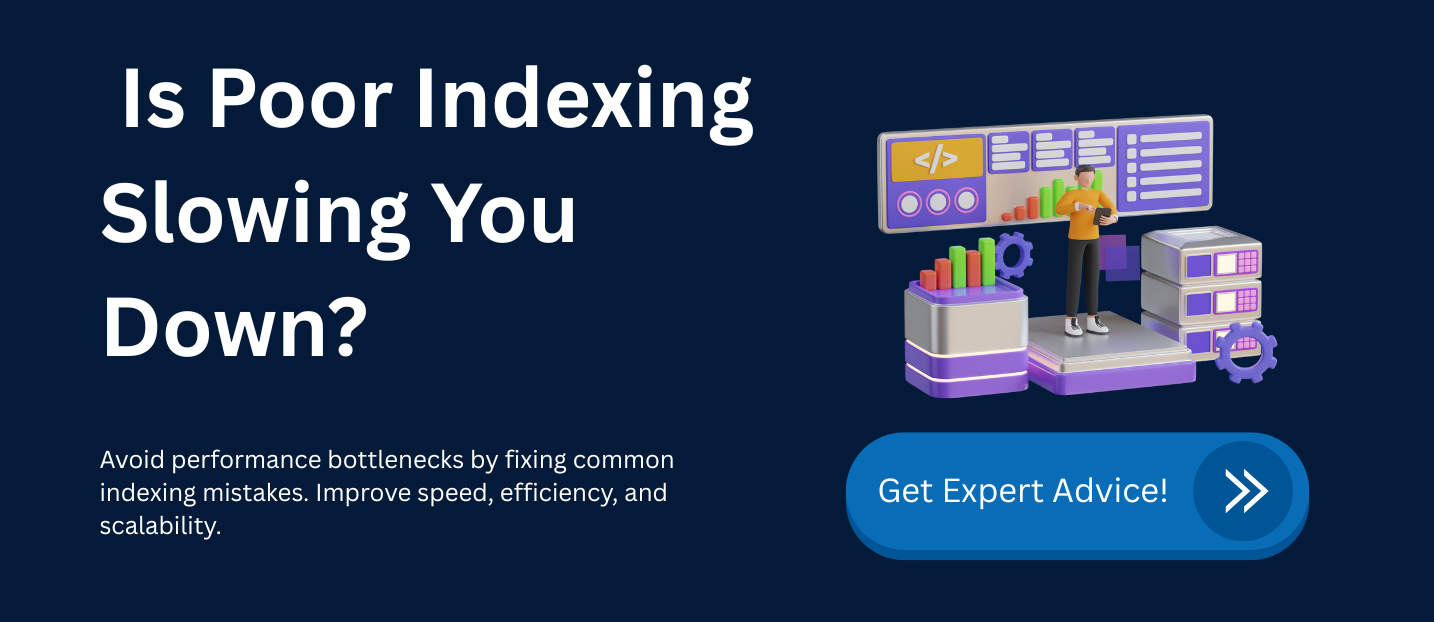Database indexing is one of those things that can make or break your application’s performance. When done right, it significantly boosts query speed and reduces database load. But when done wrong? It can lead to slow queries, bloated storage, and even system crashes at scale.
1. Not Having Any Indexes at All
Yes, this happens more often than you’d think. Many developers assume that modern databases are fast enough by default and forget that indexes are what make queries truly efficient.
→ Why It’s a Problem
Without indexes, your database has to scan every row in a table to find the requested data (a full table scan). This works fine for small tables, but once you have millions of rows, queries become painfully slow.
→ How to Fix It
- Identify slow queries using
EXPLAIN(MySQL, PostgreSQL) orEXPLAIN ANALYZE. - Add indexes on frequently searched columns, especially those used in
WHERE,JOIN, andORDER BYclauses.
2. Using Too Many Indexes
The opposite of the first mistake—some developers get index-happy and add an index to every column they see.
→ Why It’s a Problem
Each index takes up extra storage and slows down write operations (INSERT, UPDATE, DELETE). The more indexes you have, the more work the database has to do when modifying data.
→ How to Fix It
- Only add indexes where queries actually benefit from them.
- Regularly review indexes and remove unused ones using
pg_stat_user_indexes(PostgreSQL) orSHOW INDEX(MySQL).
3. Indexing Every Column in a Table
A common myth: “More indexes = faster queries.” This isn’t true because not all indexes are used equally.
→ Why It’s a Problem
- Indexes aren’t free—each one adds overhead.
- If a table has 10+ indexes, inserting a row can become extremely slow.
→ How to Fix It
- Focus on indexing only the necessary columns (not every column in the table).
- Use composite indexes instead of multiple single-column indexes.
4. Ignoring Composite Indexes
A composite index is an index on multiple columns. Many developers make the mistake of adding single-column indexes instead of a well-thought-out composite index.
→ Why It’s a Problem
Let’s say you frequently run this query:
If you create separate indexes on user_id and status, the database might not use both efficiently.
→ How to Fix It
- Use a composite index instead:
- Always put the most selective column first in the index.
5. Forgetting to Index Foreign Keys
Foreign keys create relationships between tables, but many developers forget to index them.
→ Why It’s a Problem
Without an index, JOIN operations on foreign key columns are slow, and deleting parent rows can lock the entire table.
→ How to Fix It
- Always add an index on foreign key columns:
- This helps speed up
JOINqueries and cascade operations.
6. Using the Wrong Order in Composite Indexes
Even when developers use composite indexes, they often put columns in the wrong order.
→ Why It’s a Problem
If you index (col1, col2), it helps with:
But it won’t help if your query is just:
because indexes work left-to-right.
→ How to Fix It
- Always put the most commonly filtered column first in the composite index.
7. Not Understanding How Indexes Affect Sorting (ORDER BY)
Indexes help with ORDER BY, but only if they match the query’s sorting order.
→ Why It’s a Problem
If you have an index on (last_name, first_name), this helps:
But it won’t help much if you change the order:
→ How to Fix It
- Align your indexes with your sorting order for better performance.
8. Not Rebuilding or Maintaining Indexes
Indexes need maintenance over time, especially in databases with frequent updates.
→ Why It’s a Problem
- Fragmentation: Frequent inserts/updates can fragment indexes, making them slower.
- Bloat: Unused indexes take up space.
→ How to Fix It
- PostgreSQL: Run
VACUUM ANALYZEorREINDEX. - MySQL: Use
OPTIMIZE TABLEfor InnoDB. - SQL Server: Run
ALTER INDEX … REBUILD.
9. Not Testing Index Performance
Many developers add indexes blindly without testing their impact.
→ Why It’s a Problem
Some indexes actually slow down performance instead of improving it.
→ How to Fix It
- Use
EXPLAIN(MySQL, PostgreSQL) to see if an index is being used. - Remove unused or inefficient indexes.
10. Assuming Indexes Solve Everything
Indexes speed up reads, but they don’t fix all performance issues.
→ Why It’s a Problem
- Indexes slow down writes (every insert/update modifies indexes).
- Bad query design still causes problems, even with indexes.
→ How to Fix It
- Optimize queries before adding indexes.
- Use caching (Redis, Memcached) for frequently accessed data.
Conclusion
Indexes are powerful tools, but only when used correctly. If you find your database slowing down, check for these mistakes:
→ Are you missing indexes on frequently queried columns?
→ Are you using too many or unnecessary indexes?
→ Are you optimizing composite indexes correctly?
→ Are you maintaining and testing your indexes?
You may also like:
1) 5 Common Mistakes in Backend Optimization
2) 7 Tips for Boosting Your API Performance
3) How to Identify Bottlenecks in Your Backend
4) 8 Tools for Developing Scalable Backend Solutions
5) 5 Key Components of a Scalable Backend System
6) 6 Common Mistakes in Backend Architecture Design
7) 7 Essential Tips for Scalable Backend Architecture
8) Token-Based Authentication: Choosing Between JWT and Paseto for Modern Applications
9) API Rate Limiting and Abuse Prevention Strategies in Node.js for High-Traffic APIs
10) Can You Answer This Senior-Level JavaScript Promise Interview Question?
11) 5 Reasons JWT May Not Be the Best Choice
12) 7 Productivity Hacks I Stole From a Principal Software Engineer
13) 7 Common Mistakes in package.json Configuration
Read more blogs from Here
Share your experiences in the comments, and let’s discuss how to tackle them!
Follow me on Linkedin

